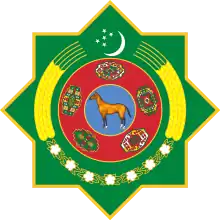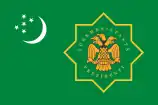| President of Turkmenistan | |
|---|---|
| Türkmenistanyň prezidenti | |
 Emblem of Turkmenistan | |
 Standard of the president of Turkmenistan | |
| Style | Mr President (informal) Distinguished President of Turkmenistan (formal) His Excellency[1] (diplomatic) |
| Type | Head of state Head of government |
| Member of | |
| Residence | Oguzkhan Presidential Palace |
| Seat | Ashgabat |
| Appointer | Direct popular vote |
| Term length | 7 years, renewable |
| Formation | 2 November 1990 (Turkmen SSR) 27 October 1991 (Turkmenistan) |
| First holder | Saparmyrat Nyýazow |
| Succession | Chairman of the Assembly of Turkmenistan |
| Deputy | Vice-President of Turkmenistan |
| Salary | 442,800 Turkmenistani manat/10,800 USD annually[2] |
The president of Turkmenistan (Turkmen: Türkmenistanyň prezidenti), officially the president and chairman of the Cabinet of Ministers of Turkmenistan, is the head of state and head of government of Turkmenistan. The president is also the supreme commander in chief of the Armed Forces of Turkmenistan and heads the State Security Council.
Serdar Berdimuhamedow is the current president of Turkmenistan, the third in the history of the country since it gained independence with the dissolution of the Soviet Union in 1991. He succeeded his father, Gurbanguly Berdimuhamedow when the latter stepped down in 2022 after a reign of 15 years, the first president to do so. In the 2022 election, Berdimuhamedow received 72.97% of the country's popular vote against nine other candidates.[3] The country passed reforms in 2016 eliminating term limits for the presidency and removing the previous age requirement of below 70, as well as extending the term from five to seven years.[4]
Requirements for presidents, removal from office, and succession
Requirements for candidates for president of Turkmenistan include the following:[5]
- Must have been born in Turkmenistan
- Must be fluent in Turkmen
- Must be at least 40 years old
- Must have resided in Turkmenistan for the past 15 consecutive years
- Must be employed
The powers of the president of Turkmenistan may be terminated in accordance with article 57 of the Turkmen constitution in the event of:
- Inability to perform their duties due to illness
- Violation of the constitution and public laws
- A vote of no confidence in the president
Should the president be removed from office as well as the in event of death or resignation, the chairman of the Assembly is legally appointed as acting president, with elections being held no later than 60 days after the fact. This has never taken place; in 2006, when Turkmenistan's only presidential vacancy occurred due to Nyýazow's death in office, the State Security Council of Turkmenistan transferred the right to act as President to the first deputy chairman of the Cabinet of Ministers on an ad-hoc basis. The requirement that an acting president does not have the right to run for president was also dropped.
Residence
The Oguzkhan Presidential Palace is the principal residence/workplace of the president, located on Independence Square in Ashgabat. The various halls of the palace are used to receive foreign leaders and sign presidential decrees. Former President Saparmyrat Nyýazow owned a private residence in an official residence in Arshabil, a town 28 kilometres outside of Ashgabat.[6]
Transport and security
The president of Turkmenistan utilises a specially made Boeing 777-200LR, painted in the national colours, during international and regional visits. These planes are provided by Turkmenistan Airlines. The president employs a Mercedes-Benz S-Class vehicle to transport him throughout the capital city. On some occasions, the vehicle is escorted by a mounted troop from the armed forces. The president also utilises trains to transport them from one place to another.
.jpg.webp)
The ' Presidential Security Service (Prezidentiniň howpsuzlyk gullugy) is responsible for ensuring the protection and security of the president. Established in November 1990, it is a direct reporting body of the President of Turkmenistan. In the early 1990s, the Presidential Security Service was removed from the National Security Committee and transformed into an independent body. On 23 September 1994, the Law of Turkmenistan "On the operative-search activity" came into force, according to which one of the main tasks of the service is to ensure the security of the President of Turkmenistan.[7] During state visits to foreign countries, the service provides at least 10 agents to protect the president.[8] The Presidential Security Service is organised in the following way:
- Secretariat
- Duty Division
- 1st Division (Personal guard of the president)
- 2nd Division
- 3rd Division
- 4th Division
- Special Operations Regiment
- 1st Battalion
- 2nd Battalion
- 3rd Battalion
The Presidential Security Service is currently composed of 2,000 employees.[9]
Constitution of Turkmenistan
The Constitution of Turkmenistan adopted on 18 May 1992 is the supreme law of Turkmenistan (Article 5). In its preamble, the Constitution emphasizes self-determination for the Turkmen people, as well as the rule of law and rights for citizens. (See also Human rights in Turkmenistan).
The 1992 constitution was amended in 1995, 1999, 2003[10] and 2006.[11] It was amended on 26 September 2008, abolishing the 2,500-member People's Council (Halk Maslahaty) and expanding the elected Assembly (Mejlis) from 65 to 125 members.[12] A new constitution was adopted on 14 September, 2016. State Flag and Constitution Day is celebrated on 18 May.
Constitution of the Turkmen SSR

There were three Constitutions of the Turkmen Soviet Socialist Republic, enacted in 1927, 1937, and 1978. The last was superseded by the modern Constitution of Turkmenistan, which came into force in 1992. It has since been amended in 2008 and 2016.[13]
Overview
Section 1
Section 1 of the 2008 Constitution is composed of 17 articles (15 articles in the 1992 Constitution). Article 1 describes Turkmenistan as a secular democracy and presidential republic. The sovereignty and the territorial integrity of the state are inviolable and indivisible. Article 3 proclaims individual rights and dignity as a value protected by the state. Article 8 states that foreign residents and persons without citizenship enjoy the same rights as the citizens of Turkmenistan subject to existing laws and international agreements. Among the rights specifically enumerated are the right to property (article 9) and freedom of religion (article 12; article 11 in the 1992 Constitution).
Article 4 endorses a separation of powers, including judicial independence. Article 14 (13 in the 1992 Constitution) establishes the Turkmen language as the official language and article 17 (15 in the 1992 Constitution) confirms Ashgabat as the capital city.
Two new articles added in the 2008 Constitution declare the state's commitment to the market economy, including encouragement of small and medium-sized business (Article 10), and specify the administrative division of the country into welayats (provinces), cities with the status of welayat, etraps (districts), towns with etrap status, towns in an etrap, and villages of different levels (Article 16, supersedes Article 47 in the 1992 Constitution).
Section 2
Section 2 outlines rights of individuals and citizens. Civil and political rights include equality rights (article 19; 1992:17), sex equality (article 20; 1992:18), freedom from cruel and unusual punishment (article 23; 1992:21), and freedom of movement (article 26; 1992:24). Social and economic rights include the right to work (article 33; 1992:31), the right to rest (article 34; 1992:32), and the right to education (article 38; 1992:35). Other social rights include the right to health care, the right to old-age pension, and the right to disability benefits (articles 35, 37; 1992:33, 34). A new article added in the 2008 Constitution (article 36) establishes the right to environmental quality and charges the state with the responsibility for preserving natural resources and protecting the environment.
Article 21 (1992:19) states that the exercise of individual rights and freedoms should not impinge on the rights and freedoms of other individuals and can be limited by considerations of morality, law, and public order. Article 22 declares that everybody has the right to life and that capital punishment is abolished in Turkmenistan. The 1992 Constitution allowed capital punishment, but only for "the heaviest of crimes" (article 20), and this provision was subsequently annulled by a 1999 presidential decree that abolished capital punishment.[14] Finally, Section 2 lists some obligations on citizens, including serving in the military (article 41; 1992:38) and paying taxes (article 42; 1992:39).
Section 3
Section 3 describes the organs of government in Turkmenistan. The state power is vested with the President, the Mejlis (Parliament or Assembly), the Cabinet of Ministers, and the Supreme Court of Turkmenistan (Article 48). The People's Council of Turkmenistan (Halk Maslahaty), which figured prominently in the 1992 Constitution (Chapter 2 of Section 3), was abolished in the 2008 Constitution.
Articles 50-58 of the 2008 Constitution (54-61 of the 1992 Constitution) describe the powers of the President of Turkmenistan. The President is the head of state and also the head of government (Article 50). The President is in charge of Turkmenistan's foreign policy and is the country's commander-in-chief (Article 53). In addition to signing laws enacted by Mejlis, he may issue Presidential decrees that have the power of law in Turkmenistan (Article 54).
List of presidents of Turkmenistan
 |
|---|
See also
References
- ↑ UNITED NATIONS HEADS OF STATE HEADS OF GOVERNMENT MINISTERS FOR FOREIGN AFFAIRS Protocol and Liaison Service
- ↑ "Зарплата для избранных". www.kommersant.ru. 9 October 2006.
- ↑ "Turkmenistan leader's son wins presidential election". AP NEWS. Associated Press. 15 March 2022. Archived from the original on 15 March 2022. Retrieved 15 March 2022.
- ↑ "The president of Turkmenistan wins re-election with 98% of the vote". The Economist. Retrieved 26 February 2017.
- ↑ "Законодательство - «Туркменистан: золотой век»". Archived from the original on 5 August 2012.
- ↑ Hiro, Dilip (November 2011). Inside Central Asia: A Political and Cultural History of Uzbekistan, Turkmenistan, Kazakhstan, Kyrgyz stan, Tajikistan, Turkey, and Iran. ISBN 9781590203781.
- ↑ "Закон Туркменистана "Об оперативно-розыскной деятельности"". base.spin form.ru.
- ↑ "Кое-что о президентской охране".
- ↑ "Some facts about the Presidential security team | Chronicles of Turkmenistan". 14 June 2013.
- ↑ "ОПУБЛИКОВАНА КОНСТИТУЦИЯ ТУРКМЕНИСТАНА С УЧЕТОМ ВНЕСЕННЫХ В НЕЕ ИЗМЕНЕНИЙ И ДОПОЛНЕНИЙ". Turkmenistan.ru. Retrieved 23 February 2019.
- ↑ "КОНСТИТУЦИОННЫЙ ЗАКОН ТУРКМЕНИСТАНА". Turkmenistan.ru. Retrieved 23 February 2019.
- ↑ "World Bulletin [ Turkmenistan adopts investor-friendly constitution ]". Archived from the original on 7 October 2008. Retrieved 26 September 2008.
- ↑ Johnson, Constance (20 September 2016). "Turkmenistan: Amended Constitution Lengthens Terms of Presidents - Global Legal Monitor". Loc.gov. Retrieved 23 February 2019.
- ↑ Abolition of capital punishment Archived 2016-11-26 at the Wayback Machine, Presidential Decree 3003, 28 December 1999 (in Russian)
.jpg.webp)